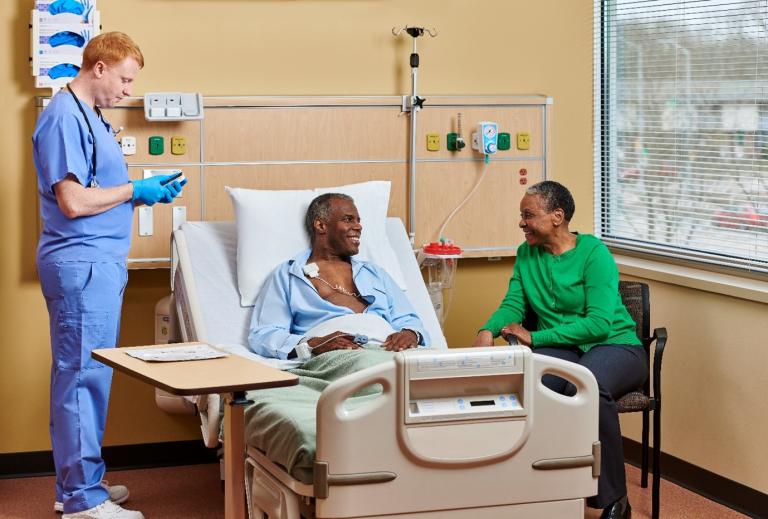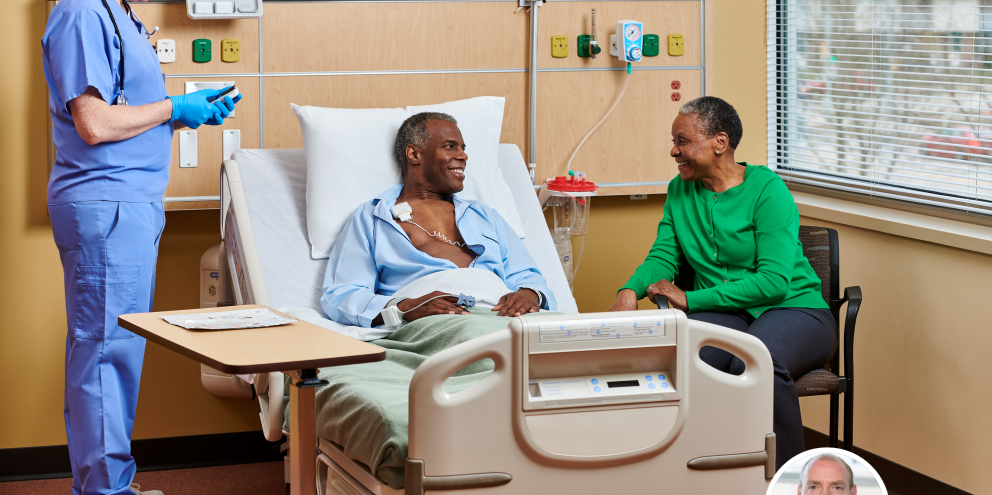
In this regard, we are thrilled to have the opportunity to speak with Professor Bernd Saugel, a highly influential Key Opinion Leader in this area and a passionate advocate for patient safety. Together, we will engage in a thought-provoking conversation about this critical issue.

Meet Professor Saugel, a highly-regarded specialist in perioperative and intensive care medicine. He has earned board certification in anaesthesiology, intensive care medicine, and internal medicine. He presently serves as Professor of Anesthesiology and Vice Chair of the Department of Anesthesiology at the Center of Anesthesiology and Intensive Care Medicine in the University Medical Center Hamburg-Eppendorf, Hamburg, Germany.
His primary field of research centres around optimising haemodynamics for patients undergoing high-risk surgeries or those critically ill. He strongly emphasises individualised hsemodynamic management to enhance patient outcomes in perioperative and intensive care medicine. Currently, he is Editor for the British Journal of Anaesthesia. He has published a multitude of original articles and didactic reviews in peer-reviewed journals. On researchgate.net, his impressive collection of 271 research items has garnered a Research Interest score of 3,293, 6,079 citations, and an h-index of 43.
In the following pages, Professor Saugel presents valuable insights gained from years of dedication to improving surgical outcomes and reducing postoperative complications. Through this interview, we will explore the many aspects of patient safety, including the challenges that continue to evolve, the innovative strategies being developed, and the ethical principles that guide this critical area of healthcare.
The healthcare industry constantly evolves with the latest surgical techniques, technology, and patient expectations. In light of this, it is essential to understand the importance of patient safety after surgery and the significant role played by Professor Saugel in shaping a safer and more secure future for surgical patients worldwide.
Are patients treated on general wards after surgery safe?
When surgery has ended, and patients are transferred to the general care ward, patients and their families naturally assume that the most dangerous part of the “perioperative experience” is over. This assumption is wrong. Over the last decades we did a great job in reducing intraoperative major complications and mortality [1]. However, complication and mortality rates in the first days and weeks after surgery are still high. Postoperative mortality is 100 times more common than intraoperative mortality [1]. About 2% of patients having inpatient surgery die within the first months after surgery [1, 2]. Two thirds of these patients die in the hospital before discharge [1]. Three quarters of patients who die after surgery are not admitted to the intensive care unit at any stage after surgery [2]. This means: After surgery, most patients who die, die on the general care wards. This contrasts with the assumption that a hospital ward – specifically the “patient’s room” – is a safe place of recovery.
Postoperative deaths are a consequence of major complications – such as bleeding or cardiovascular and respiratory complications. Abnormal vital signs –hypotension, tachycardia, or hypoxemia – are clinical symptoms of these complications and often occur hours before a patient crashes. However, vital signs are not closely monitored on general care wards.
Why would close monitoring of vital signs be important?
Critical cardiocirculatory or respiratory events usually do not appear suddenly. These critical events appear to happen suddenly because we recognize them suddenly – usually during rounds. We know, however, that life-threatening complications are usually preceded by subtle vital sign alterations that occur hours earlier [3-5]. Subtle changes in respiratory rate, heart rate, blood pressure, or oxygen saturation are early signs of clinical deterioration eventually leading to critical events. Continuously monitoring vital signs could allow us to recognize these early signs – instead of just noticing that a patient “suddenly crashed”. Continuous ward monitoring may thus improve patient safety on general care wards.
What is the standard for ward monitoring in major academic hospitals in Europe and the US?
Monitoring on general care wards – outside the operating room and the intensive care unit – is still basic and intermittent. Vital signs are not closely monitored on general care wards but rather checked sporadically. Nurses usually perform spot checks at intervals of 4-8 hours. Notably, it is astonishing that monitoring on general care wards has hardly changed over the last decades, although patients in hospitals are now older, sicker, and frailer than previously. This is true for both large academic centers and smaller hospitals – and in my experience it is true throughout Europe and the US.
Why are spot checks not the right answer to post-operative monitoring?
Spot checks at intervals of 4-8 hours leave patients unmonitored for most of the time, thus fail to identify early vital sign alterations and patient deterioration. For example, it has been shown that spot checks miss hypoxaemia, hypotension, tachycardia, and tachypnoea [6-9]. Additionally, respiratory rate (that is an important predictor of clinical deterioration [10]) is often not assessed at all [11] – and if it is, it is assessed inaccurately [12].
What is the solution to detect patient deterioration on wards?
Continuous vital sign monitoring could allow recognizing subtle vital sign changes early and recognize clinical deterioration well before serious adverse events occur [13]. Continuous ward monitoring thus seems likely to identify deterioration earlier than current spot check monitoring.
How would an ideal ward monitoring system look like?
Continuous ward monitoring requires small, untethered, “wireless” monitoring systems with sensors to monitor various physiologic variables – including heart rate, oxygen saturation, respiratory rate, blood pressure, body position, activity, and location [14, 15]. The ideal continuous ward monitoring device needs to be small, wireless, and wearable [15]. Ward monitoring systems need to be validated rigorously to ensure that their measurement performance is clinically acceptable [16]. Further, ward monitoring will only improve patient-centred outcomes if monitoring data are processed and analysed in real-time and trigger an immediate response by clinicians. There are “before-and-after” studies suggesting that implementing automated monitoring systems on general care wards and linking in combination with notification systems results in improvements in patient-centered outcomes [17-20]. We will need robust trials showing that continuous ward monitoring improves outcome compared to current routine monitoring.
What are the obstacles on the way to implementing continuous ward monitoring systems into clinical practice?
Continuous ward monitoring seems to be the key to detect patient deterioration on general care wards. However, a huge effort is needed to implement continuous ward monitoring in clinical practice. This will not only require profoundly changing the way we think about ward monitoring but also overcoming technical obstacles [13, 21, 22]: Sensors need to monitor the patient continuously – without limiting patient comfort and mobility. Measurement artifacts need to be filtered to avoid alarm fatigue. Ward monitoring systems need to be integrated into existing electronic medical record systems. We will need to establish response strategies when ward monitoring indicates that a patient deteriorates. In other words, monitoring systems need to direct the alert to the right person – the ward nurse or a Rapid Response Team. Further, we will need to get insights into how continuous patient monitoring affects the workload of nurses.
Conclusions:
As we wrap up our insightful discussion with Professor Saugel, it is glaringly evident that ensuring patient safety following surgery should be given utmost priority. Professor Saugel's deep understanding of the subject has shed light on the intricate post-surgical care landscape, highlighting the significance of collaborative efforts, continuous learning, and the use of advanced technologies to safeguard the health of patients.
References:
- Investigators VEiNSPCEVS: Association between complications and death within 30 days after noncardiac surgery. CMAJ : Canadian Medical Association journal = journal de l'Association medicale canadienne 2019, 191(30):E830-e837.
- Pearse RM, Moreno RP, Bauer P, Pelosi P, Metnitz P, Spies C, Vallet B, Vincent JL, Hoeft A, Rhodes A et al: Mortality after surgery in Europe: a 7 day cohort study. Lancet (London, England) 2012, 380(9847):1059-1065.
- Jones D, Mitchell I, Hillman K, Story D: Defining clinical deterioration. Resuscitation 2013, 84(8):1029-1034.
- Chen L, Ogundele O, Clermont G, Hravnak M, Pinsky MR, Dubrawski AW: Dynamic and Personalized Risk Forecast in Step-Down Units. Implications for Monitoring Paradigms. Annals of the American Thoracic Society 2017, 14(3):384-391.
- Andersen LW, Kim WY, Chase M, Berg KM, Mortensen SJ, Moskowitz A, Novack V, Cocchi MN, Donnino MW, American Heart Association's Get With the Guidelines - Resuscitation I: The prevalence and significance of abnormal vital signs prior to in-hospital cardiac arrest. Resuscitation 2016, 98:112-117.
- Sun Z, Sessler DI, Dalton JE, Devereaux PJ, Shahinyan A, Naylor AJ, Hutcherson MT, Finnegan PS, Tandon V, Darvish-Kazem S et al: Postoperative Hypoxemia Is Common and Persistent: A Prospective Blinded Observational Study. Anesthesia and analgesia 2015, 121(3):709-715.
- Turan A, Chang C, Cohen B, Saasouh W, Essber H, Yang D, Ma C, Hovsepyan K, Khanna AK, Vitale J et al: Incidence, Severity, and Detection of Blood Pressure Perturbations after Abdominal Surgery: A Prospective Blinded Observational Study. Anesthesiology 2019, 130(4):550-559.
- Saab R, Wu BP, Rivas E, Chiu A, Lozovoskiy S, Ma C, Yang D, Turan A, Sessler DI: Failure to detect ward hypoxaemia and hypotension: contributions of insufficient assessment frequency and patient arousal during nursing assessments. Br J Anaesth 2021.
- Duus CL, Aasvang EK, Olsen RM, Sorensen HBD, Jorgensen LN, Achiam MP, Meyhoff CS: Continuous vital sign monitoring after major abdominal surgery-Quantification of micro events. Acta anaesthesiologica Scandinavica 2018, 62(9):1200-1208.
- Churpek MM, Yuen TC, Winslow C, Robicsek AA, Meltzer DO, Gibbons RD, Edelson DP: Multicenter development and validation of a risk stratification tool for ward patients. American journal of respiratory and critical care medicine 2014, 190(6):649-655.
- Ludikhuize J, Smorenburg SM, de Rooij SE, de Jonge E: Identification of deteriorating patients on general wards; measurement of vital parameters and potential effectiveness of the Modified Early Warning Score. Journal of critical care 2012, 27(4):424 e427-413.
- Badawy J, Nguyen OK, Clark C, Halm EA, Makam AN: Is everyone really breathing 20 times a minute? Assessing epidemiology and variation in recorded respiratory rate in hospitalised adults. BMJ Qual Saf 2017, 26(10):832-836.
- Sessler DI, Saugel B: Beyond 'failure to rescue': the time has come for continuous ward monitoring. Br J Anaesth 2019, 122(3):304-306.
- McGillion MH, Duceppe E, Allan K, Marcucci M, Yang S, Johnson AP, Ross-Howe S, Peter E, Scott T, Ouellette C et al: Postoperative Remote Automated Monitoring: Need for and State of the Science. The Canadian journal of cardiology 2018, 34(7):850-862.
- Michard F, Sessler DI: Ward monitoring 3.0. British journal of anaesthesia 2018, 121(5):999-1001.
- Saugel B, Hoppe P, Khanna AK: Automated Continuous Noninvasive Ward Monitoring: Validation of Measurement Systems Is the Real Challenge. Anesthesiology 2020, 132(3):407-410.
- Bellomo R, Ackerman M, Bailey M, Beale R, Clancy G, Danesh V, Hvarfner A, Jimenez E, Konrad D, Lecardo M et al: A controlled trial of electronic automated advisory vital signs monitoring in general hospital wards. Critical care medicine 2012, 40(8):2349-2361.
- Subbe CP, Duller B, Bellomo R: Effect of an automated notification system for deteriorating ward patients on clinical outcomes. Critical care (London, England) 2017, 21(1):52.
- Taenzer AH, Pyke JB, McGrath SP, Blike GT: Impact of pulse oximetry surveillance on rescue events and intensive care unit transfers: a before-and-after concurrence study. Anesthesiology 2010, 112(2):282-287.
- Brown H, Terrence J, Vasquez P, Bates DW, Zimlichman E: Continuous monitoring in an inpatient medical-surgical unit: a controlled clinical trial. The American journal of medicine 2014, 127(3):226-232.
- Khanna AK, Hoppe P, Saugel B: Automated continuous noninvasive ward monitoring: future directions and challenges. Critical care (London, England) 2019, 23(1):194.
- Flick M, Saugel B: Continuous ward monitoring: the selection, monitoring, alarms, response, treatment (SMART) road map. Br J Anaesth 2021.

Prof. Bernd Saugel
Highly-regarded specialist in perioperative and intensive care medicine. He has earned board certification in anaesthesiology, intensive care medicine, and internal medicine. He presently serves as Professor of Anesthesiology and Vice Chair of the Department of Anesthesiology at the Center of Anesthesiology and Intensive Care Medicine in the University Medical Center Hamburg-Eppendorf, Hamburg, Germany.
His primary field of research centres around optimising haemodynamics for patients undergoing high-risk surgeries or those critically ill. He strongly emphasises individualised hsemodynamic management to enhance patient outcomes in perioperative and intensive care medicine. Currently, he is Editor for the British Journal of Anaesthesia. He has published a multitude of original articles and didactic reviews in peer-reviewed journals. On researchgate.net, his impressive collection of 271 research items has garnered a Research Interest score of 3,293, 6,079 citations, and an h-index of 43.







